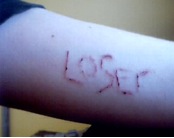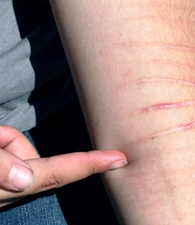What is self-injury?
Self-injury is deliberate and purposeful injury to oneself.
The term self-injury is used instead of ‘self-harm’ as it is a more neutral, with ‘harm’ suggesting the behaviour is inherently negative or damaging. Also, according to some definitions ‘self harm’ is inclusive of suicidality (RANZCP, 2009, attached).
Self-injury is a behavior that has a function. Most commonly self-injury is a way of reducing or managing emotional or psychological distress. It is incorrect to assume that self -injury is motivated by suicidal tendencies, although it is possible that people who self injure might become suicidal. Rather than being associated with a desire to end one’s life, self-injury can be understood as a choice to continue living despite the experience of serious distress. Even so, people with a pattern of self-injury have statistically higher chance of committing suicide (Martin et al, 2010; Klonsky et al, 2007). This is not surprising, given the high levels of distress experienced by many people who self-injure as a way of coping.
‘I didn’t want to kill myself, I just wanted some of the hurt & all the pain just to go away’. Rachel (late teens)
‘It’s something that needs to be done to get me living’. Vicky (25)
‘People always look at the negatives of self-harm whereas they should actually look at ‘the positives, & the positives is the person is still alive’. Mel (late teens)
‘If I wanted to die when I self-harmed, then I wouldn’t be here, because I’d have made sure’. Kirsty (early 20’s)
‘The only time I overdose is when I want to die. The cutting up’s not about wanting to die, whereas the overdoses were because I wanted to die’. Sharon (early 20’s)
(Look beyond the scars, NCH, U.K, 2002)
Also, it should not be assumed that young people who self-injure have a mental illness or a psychiatric diagnosis. It is often incorrectly assumed that people who have a history of self-injury also have “Borderline Personality Disorder”. While some people who self-injure are correctly diagnosed with this disorder, it does not apply to all people who people who self-injure.

Examples of self-injury
The most common form of self-injury is cutting with a sharp, sometimes improvised, object. Also common is scratching, burning, or bruising the skin, and wound interference. Other forms of self-injury are hitting objects or self, hair-pulling, swallowing, inserting or injecting objects or toxic substances, fractures or dislocations of bones or joints.



